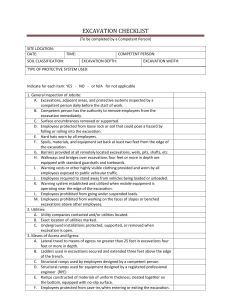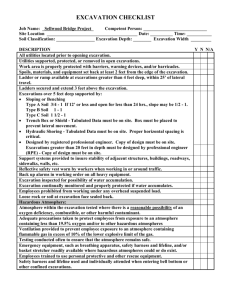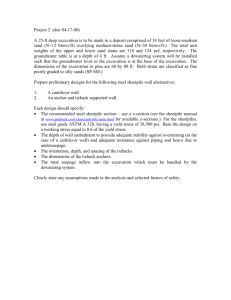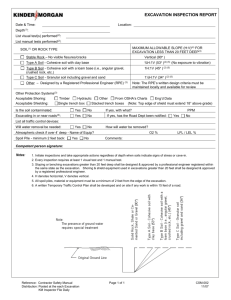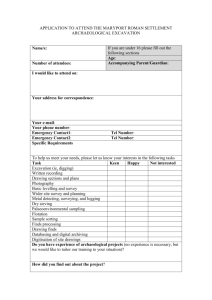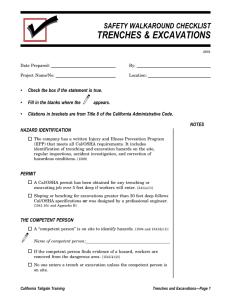Excavation Checklist: Safety & Compliance
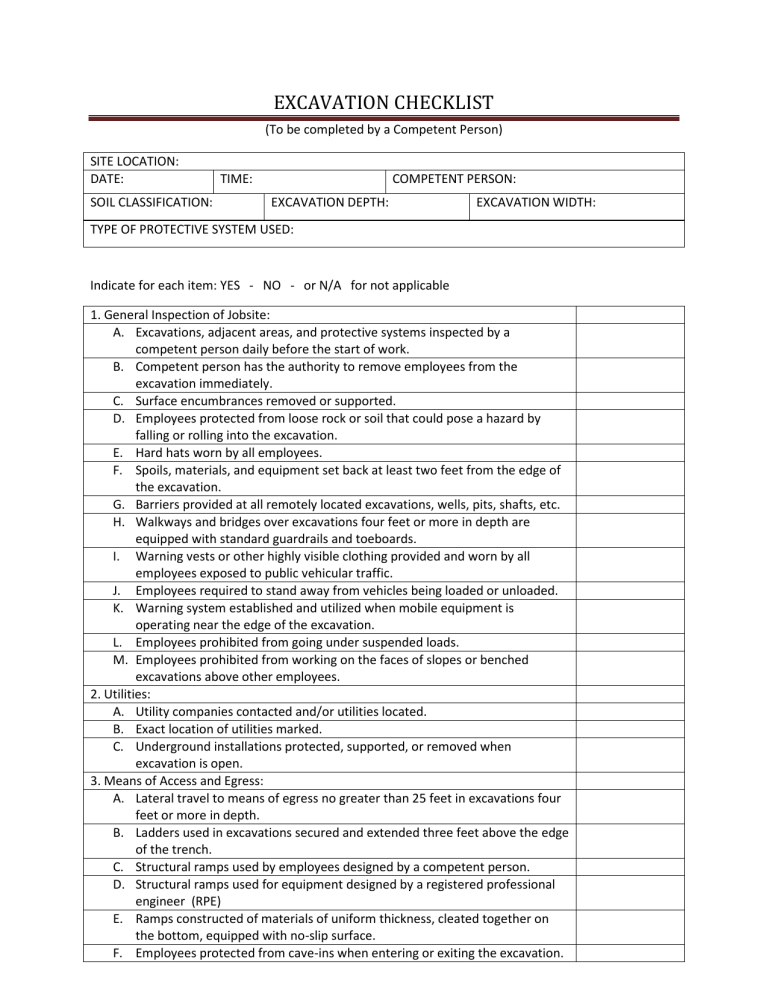
EXCAVATION CHECKLIST
(To be completed by a Competent Person)
SITE LOCATION:
DATE:
SOIL CLASSIFICATION:
TIME:
EXCAVATION DEPTH:
COMPETENT PERSON:
EXCAVATION WIDTH:
TYPE OF PROTECTIVE SYSTEM USED:
Indicate for each item: YES - NO - or N/A for not applicable
1. General Inspection of Jobsite:
A.
Excavations, adjacent areas, and protective systems inspected by a competent person daily before the start of work.
B.
Competent person has the authority to remove employees from the excavation immediately.
C.
Surface encumbrances removed or supported.
D.
Employees protected from loose rock or soil that could pose a hazard by falling or rolling into the excavation.
E.
Hard hats worn by all employees.
F.
Spoils, materials, and equipment set back at least two feet from the edge of the excavation.
G.
Barriers provided at all remotely located excavations, wells, pits, shafts, etc.
H.
Walkways and bridges over excavations four feet or more in depth are equipped with standard guardrails and toeboards.
I.
Warning vests or other highly visible clothing provided and worn by all employees exposed to public vehicular traffic.
J.
Employees required to stand away from vehicles being loaded or unloaded.
K.
Warning system established and utilized when mobile equipment is operating near the edge of the excavation.
L.
Employees prohibited from going under suspended loads.
M.
Employees prohibited from working on the faces of slopes or benched excavations above other employees.
2. Utilities:
A.
Utility companies contacted and/or utilities located.
B.
Exact location of utilities marked.
C.
Underground installations protected, supported, or removed when excavation is open.
3. Means of Access and Egress:
A.
Lateral travel to means of egress no greater than 25 feet in excavations four feet or more in depth.
B.
Ladders used in excavations secured and extended three feet above the edge of the trench.
C.
Structural ramps used by employees designed by a competent person.
D.
Structural ramps used for equipment designed by a registered professional engineer (RPE)
E.
Ramps constructed of materials of uniform thickness, cleated together on the bottom, equipped with no-slip surface.
F.
Employees protected from cave-ins when entering or exiting the excavation.
4. Wet Conditions:
A.
Precautions take to protect employees from the accumulation of water.
B.
Water removal equipment monitored by a competent person.
C.
Surface water or runoff diverted or controlled to prevent accumulation in the excavation.
D.
Inspections made after every rainstorm or other hazard-increasing occurrence.
5. Hazardous Atmosphere:
A.
Atmosphere within the excavation tested where there is a reasonable possibility of an oxygen deficiency, combustible or other harmful contaminant exposing employees to a hazard.
B.
Adequate precautions taken to protect employees from exposure to an atmosphere containing less than 19.5% oxygen and/or to other hazardous atmospheres
C.
Ventilation provided to prevent employee exposure to an atmosphere containing flammable gas in excess of 10% of the lower explosive limit of the gas.
D.
Testing conducted often to ensure that the atmosphere remains safe.
E.
Emergency equipment, such as breathing apparatus, safety harness and lifeline, and/or basket stretcher readily available where hazardous atmospheres could or do exist.
F.
Employees trained to use personal protective and other rescue equipment.
G.
Safety harness and lifeline used and individually attended when entering bell bottom or other deep confined excavations.
6. Support Systems:
A.
Materials and/or equipment for support systems selected based on soil analysis, trench depth, and expected loads.
B.
Materials and equipment used for protective systems inspected and in good condition.
C.
Materials and equipment not in good condition have been removed from service.
D.
Damaged materials and equipment used for protective systems inspected by a registered professional engineer (RPE) after repairs and before being placed back into service.
E.
Protective systems installed without exposing employees to the hazards of cave-ins, collapses, or threat of being struck by materials or equipment.
F.
Members of support system securely fastened to prevent failure.
G.
Support systems provided in ensure stability of adjacent structures, buildings, roadways, sidewalks, walls, etc.
H.
Excavations below the level of the base or footing supported, approved by an RPE.
I.
Removal of support systems progresses from the bottom and members are released lowly as to note any indication of possible failure.
J.
Backfilling progresses with removal of support system.
K.
Excavation of material to a level no greater than two feet below the bottom of the support system and only if the system is designed to support the loads calculated for the full depth.
L.
Shield system placed to prevent lateral movement.
M.
Employees are prohibited from remaining in shield system during vertical movement.
DAILY TRENCHING LOG
SIGNATURE: DATE:
WEATHER: PROJECT:
Was One Call System contacted: Yes ________ No ________
Protective system: Trench shield (box) _____ Wood shoring ______
Sloping _______ Other ______
Purpose of trenching: Drainage _______ Water ______
Sewer ______ Gas ______
Other ________________________________
Were visual soil tests made: Yes_________ No _________
If yes, what type?
Type of Soil: Stable Rock _______ Type A ________ Type B _______ Type C ________
Surface encumbrances: Yes ________ No _________
If yes, what type?
Water conditions: Wet ______ Dry _______ Submerged ________
Hazardous atmosphere exists: Yes ________ No _________
(If yes, follow confined space entry procedures policy; complete confined Space Entry Permit; monitor for toxic gas(es))
Is trenching or excavation exposed to public vehicular traffic (exhaust emission): Yes ______ No ______
(If yes, refer to confined space entry procedures; complete Confined Space Entry Permit; monitor for toxic gas(es))
Measurements of trench: Depth _______ Length _______ Width ________
Is ladder within 25 feet of all workers: Yes ________ No _________
Is excavated material stored two feet or more from edge of excavation: Yes _______ No_______
Are employees exposed to public vehicular traffic: Yes ________ No________
(If yes, warning vests required)
Are other utilities protected: Yes ________ No ________
(Water, sewer, gas or other structures)
Are sewer or natural gas lines exposed: Yes _______ No ________
Periodic Inspection: Yes _______ No _________
Did employees receive training in excavating: Yes _______ No _________
Corrective Actions and Remarks:

